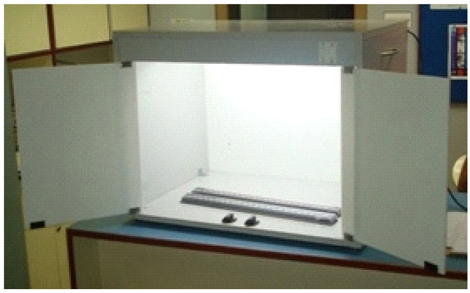Korean J Ophthalmol.
2010 Jun;24(3):159-162. 10.3341/kjo.2010.24.3.159.
Effect of Illumination on Colour Vision Testing with Farnsworth-Munsell 100 Hue Test: Customized Colour Vision Booth versus Room Illumination
- Affiliations
-
- 1Elite School of Optometry, Sankara Nethralaya, Chennai, Tamil Nadu, India.
- 2Department of Preventive Ophthalmology, Sankara Nethralaya, Chennai, Tamil Nadu, India.
- 3Shri Bhagwan Mahavir Vitreoretinal Services, Sankara Nethralaya, Chennai, Tamil Nadu, India. drtaruns@gmail.com
- KMID: 945986
- DOI: http://doi.org/10.3341/kjo.2010.24.3.159
Abstract
- PURPOSE
To evaluate a customized, portable Farnsworth-Munsell 100 (FM 100) hue viewing booth for compliance with colour vision testing standards and to compare it with room illumination in subjects with normal colour vision (trichromats), subjects with acquired colour vision defects (secondary to diabetes mellitus), and subjects with congenital colour vision defects (dichromats). METHODS: Discrete wavelengths of the tube in the customized booth were measured using a spectrometer using the normal incident method and were compared with the spectral distribution of sunlight. Forty-eight subjects were recruited for the study and were divided into 3 groups: Group 1, Normal Trichromats (30 eyes); Group 2, Congenital Colour Vision Defects (16 eyes); and Group 3, Diabetes Mellitus (20 eyes). The FM 100 hue test performance was compared using two illumination conditions, booth illumination and room illumination. RESULTS: Total error scores of the classical method in Group 2 as mean+/-SD for room and booth illumination was 243.05+/-85.96 and 149.85+/-54.50 respectively (p=0.0001). Group 2 demonstrated lesser correlation (r=0.50, 0.55), lesser reliability (Cronbach's alpha, 0.625, 0.662) and greater variability (Bland & Altman value, 10.5) in total error scores for the classical method and the moment of inertia method between the two illumination conditions when compared to the other two groups. CONCLUSIONS: The customized booth demonstrated illumination meeting CIE standards. The total error scores were overestimated by the classical and moment of inertia methods in all groups for room illumination compared with booth illumination, however overestimation was more significant in the diabetes group.
Keyword
MeSH Terms
Figure
Cited by 1 articles
-
Comparison of Contrast Sensitivity and Color Vision according to the Different Illumination in Patients with Cataract
Yo Sep Yoon, Chang Kyu Lee, Sang Ook Kang, Sang Woo Kim
J Korean Ophthalmol Soc. 2018;59(7):622-628. doi: 10.3341/jkos.2018.59.7.622.
Reference
-
1. Smith VC, Ernest JT, Pokorny J. Effect of hypoxia on FM 100-Hue test performance. Mod Probl Ophthalmol. 1976. 17:248–256.2. Farnsworth D. The Farnsworth-Munsell 100-hue test for the examination of color discrimination. 1957. Revised ed. Baltimore: Munsell Color Company;2–5.3. Johnson DD. The True Daylight Illuminator (TDI): a less expensive source of illumination for color vision screening. J Am Optom Assoc. 1992. 63:491–495.4. Lakowski R. Theory and practice of colour vision testing: a review 2. Br J Ind Med. 1969. 26:265–288.5. Milburn NJ, Mertens HW. Validation of an inexpensive illuminant for aeromedical color vision screening: final report. 1993. Springfield: National Technical Information Service;1–11.6. Birch J. Diagnosis of defective colour vision. 2001. 2nd ed. Oxford: Butterworth-Heinemann;123–125.7. Judd DB, Macadam DL, Wyszecki G, et al. Spectral distribution of typical daylight as a function of correlated color temperature. J Opt Soc Am. 1964. 54:1031–1036.8. Barton FB, Fong DS, Knatterud GL. ETDRS Research Group. Classification of Farnsworth-Munsell 100-hue test results in the early treatment diabetic retinopathy study. Am J Ophthalmol. 2004. 138:119–124.
- Full Text Links
- Actions
-
Cited
- CITED
-
- Close
- Share
- Similar articles
-
- Evaluation of congenital colour vision deficiencies
- A Computerized Scoring Method of The Hahn Double 15 Hue Test
- Color Vision Defect Associated with Diabetic Retinopathy
- Seohan Computerized Hue Test [1]: The Development of Computerized Color Vision Test and Pilot Study
- Effect of the Illumination and the Types of the Lenses on Near Visual Acuity in Low Vison Patients


